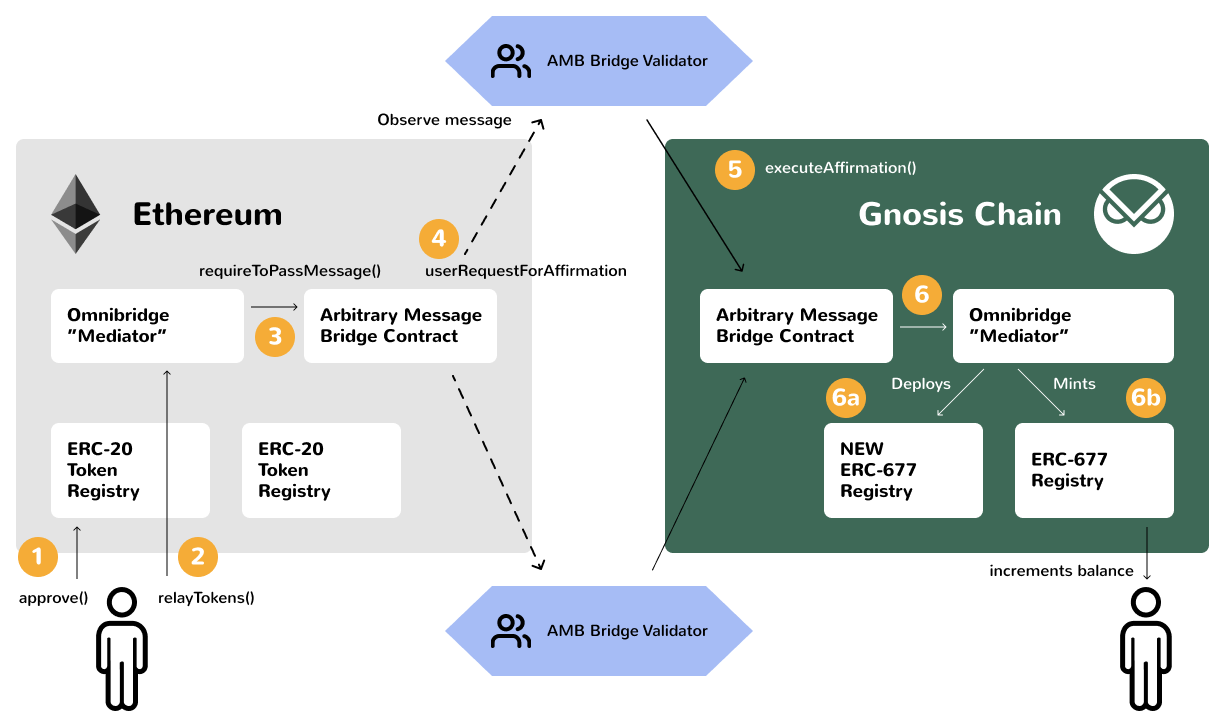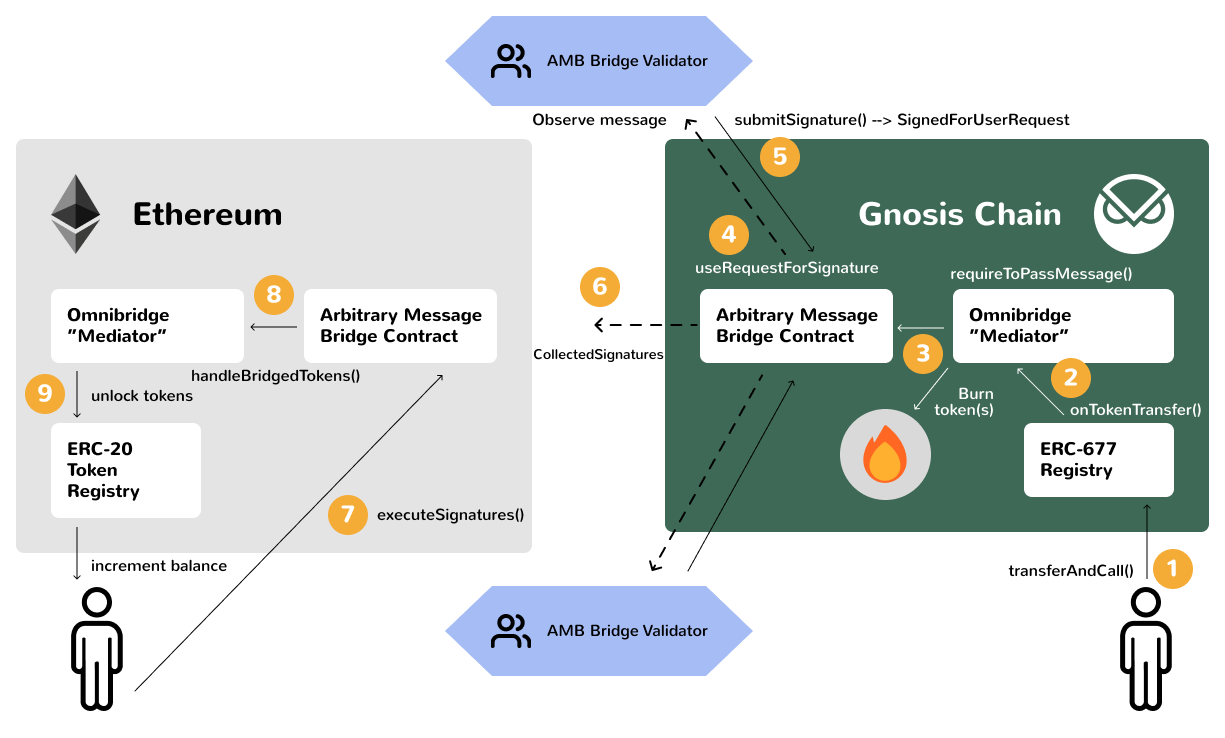Omnibridge
The Omnibride can be used in https://bridge.gnosischain.com/.
Please avoid using the legacy Omnibridge: https://omni.legacy.gnosischain.com/bridge
Key Information
Omnibridge is a native token bridge that mints the canonical representations of bridged assets on Gnosis. The Omnibridge is built on top of the Arbitrary Message Bridge (AMB) and thus relies on the same group of bridge validators and trust model as the AMB.
The Omnibridge currently connects Gnosis to Ethereum.
The Omnibridge mints bridged tokens using a variant of the ERC-677 token standard, with all bridged tokens tracked in the canonical Bridged Token Registries.
Overview
| Detail | |
|---|---|
| Frontend URL | https://bridge.gnosischain.com/ |
| Trust Model | 4-of-7 Validator Multisig |
| Governance | 8-of-15 Multisig |
| Governance Parameters | Validator Set, Daily Limits, Fees |
| Bug Bounty | up to $2m |
| Bug Reporting | Immunefi |
Key Contracts
- Ethereum
- Gnosis
- Sepolia-Chiado
Ethereum
| Contract | Ethereum Address |
|---|---|
| AMB Proxy Contract (Foreign) | 0x4C36d2919e407f0Cc2Ee3c993ccF8ac26d9CE64e |
| Omnibridge Multi-Token Mediator Proxy | 0x88ad09518695c6c3712AC10a214bE5109a655671 |
| Validator Management Contract | 0xed84a648b3c51432ad0fD1C2cD2C45677E9d4064 |
Gnosis
| Contract | Gnosis Address |
|---|---|
| AMB Proxy Contract (Home) | 0x75Df5AF045d91108662D8080fD1FEFAd6aA0bb59 |
| Omnibridge Multi-Token Mediator Proxy | 0xf6A78083ca3e2a662D6dd1703c939c8aCE2e268d |
| Validator Management Contract | 0xA280feD8D7CaD9a76C8b50cA5c33c2534fFa5008 |
| USDS Transmuter Contract | 0x0392a2f5ac47388945d8c84212469f545fae52b2 |
Sepolia - Chiaado
| Contract | Address |
|---|---|
| Omnibrdge (Sepolia) | 0x63e47c5e3303dddcaf3b404b1ccf9eb633652e9e |
| AMB (Sepolia) | 0xf2546d6648bd2af6a008a7e7c1542bb240329e11 |
| Validator Contract (Sepolia) | 0xa0bd95dd2570632c8640ab5bc213f3a0ea33e26a |
| Omnibridge (Chiado) | 0x82f63B9730f419CbfEEF10d58a522203838d74c8 |
| AMB (Chiado) | 0x8448E15d0e706C0298dECA99F0b4744030e59d7d |
| Validator Contract (Chiado) | 0x9e8a89ebcb83065eaaf4b7ff720caa5e6b25c976 |
Bridging DAI token to Gnosis Chain DOES NOT mint native xDai token. If you want native xDai, use the xDai Bridge
*** Bridging Dai Using Omnibridge
Daily Limit is reset according to the following logic: the smart contract stores total amount of processed tokens per current day and reverts on a new transfer if it exceeds the daily limit. Id of the day is calculated using the formula timestamp / (number of seconds in 1 day), where timestamp is the Unix timestamp.
Terminology
- Home (Native) Network: Gnosis Chain.
- Foreign Network: Ethereum.
- Mediator Contract: Omnibridge contract, built on top of AMB.
Bridge Validators
- See Bridge Validator
Bridge Governance
How it works
The Omnibridge is built on top of the Arbitrary Message Bridge.
Ethereum -> Gnosis

- User
approveOmnibridge as token spender. - User call
relayTokens()on Foreign Omnibridge contract. - Omnibridge contract calls Foreign AMB
requireToPassMessage(). UserRequestForAffirmationevent is emitted from Foreign AMB andTokensBridgingInitiated(address indexed token, address indexed sender, uint256 value, bytes32 indexed messageId)event is emitted from Foreign Omnibridge.- Message is relayed to the Omnibridge contract when bridge validator threshold is met by calling Home AMB
executeAffirmation()on Gnosis Chain. - AMB calls Omnibridge on Gnosis chain:
- token does not exist: the Omnibridge deploys a new token registry and mints the relayed amount.
- token exists: the relayed Omnibridge is minted in the token address.
Gnosis -> Ethereum.

-
User calls
transferAndCallon ERC-677 token contract to send tokens to Omnibridge contract -
OnTokenTransferis called -
Home Omnibridge contract burns tokens and calls bridge contract's
requireToPassMessage()function. -
UseRequestForSignatureevent is emitted for validators to validate the message. -
Validators listen to the event: call
submitSignatureon Gnosis chain. -
CollectedSignaturesevent is emitted when enough bridge validator's signature is collected. -
User calls AMB
executeSignatures()on Ethereum. To fetch the calldata for the function, please check guideline here -
AMB calls
handleBridgedTokens()on Foreign Omnibridge contract. -
Foreign Omnibridge contract unlocks the tokens.
Exceptions and Special Cases
While most tokens can be freely transferred between chains, there are several exceptions where token properties create bridge-related issues.
- Bridge operations are disabled for Rebasing tokens.
- Inflationary tokens can still be bridged, but any accrued inflation IS NOT returned to the user upon bridge exit.
Rebasing Tokens
Rebasing tokens include an elastic function where supply can be increased or decreased at regular intervals. If these tokens are bridged, supply impacts could result in inequities on either side of the bridge. In some cases this could result in a bridge balance reduction and the inability for users to exit. To prevent this, we have disabled bridging capability for rebasing type tokens. A partial token list is included below:
Click to View List
| Name | Symbol | Address |
|---|---|---|
| Base Protocol | BASE | 0x07150e919b4de5fd6a63de1f9384828396f25fdc |
| USDf | USDf | 0x05462671c05adc39a6521fa60d5e9443e9e9d2b9 |
| xBTC | XBTC | 0xecbf566944250dde88322581024e611419715f7a |
| Debase | DEBASE | 0x9248c485b0b80f76da451f167a8db30f33c70907 |
| Coil | COIL | 0x3936ad01cf109a36489d93cabda11cf062fd3d48 |
| Dollars | USDX | 0x2f6081e3552b1c86ce4479b80062a1dda8ef23e3 |
| RMPL | RMPL | 0xe17f017475a709de58e976081eb916081ff4c9d5 |
| Rebased | REB2 | 0x87f5f9ebe40786d49d35e1b5997b07ccaa8adbff |
| VELO Token | VLO | 0x98ad9b32dd10f8d8486927d846d4df8baf39abe2 |
| Tokens of Babel | TOB | 0x7777770f8a6632ff043c8833310e245eba9209e6 |
| Rise Protocol | RISE | 0x3fa807b6f8d4c407e6e605368f4372d14658b38c |
| Soft Link | SLINK | 0x10bae51262490b4f4af41e12ed52a0e744c1137a |
| Ramifi Protocol | RAM | 0xac6fe9aa6b996d15f23e2e9a384fe64607bba7d5 |
| GRPL Finance | GRPL | 0x15e4132dcd932e8990e794d1300011a472819cbd |
| Xdef Finance | XDEF2 | 0x5166d4ce79b9bf7df477da110c560ce3045aa889 |
| Antiample | XAMP | 0xf911a7ec46a2c6fa49193212fe4a2a9b95851c27 |
Inflationary (Staking) Tokens
Inflationary tokens accrue additional value over time. While they are locked in the bridge contract this value will accrue, but will remain on the balance of the bridge upon exit. Inflation will not be returned to a user's balance. This maintains the 1 to 1 ratio of bridged tokens necessary for OmniBridge functionality. Users are free to bridge these tokens but need to be aware that any accrued inflation will not be added to their balances. Usage of the accumulated inflation will be determined at a later time by bridge governors. A partial token list of inflationary tokens is included below:
Click to View List
| Name | Symbol | Address |
|---|---|---|
| Lido Staked Ether | stETH | 0xae7ab96520de3a18e5e111b5eaab095312d7fe84 |
| StakeHound Staked Ether | STETH | 0xdfe66b14d37c77f4e9b180ceb433d1b164f0281d |
| ankrETH | AETH | 0xe95a203b1a91a908f9b9ce46459d101078c2c3cb |
| Cream ETH 2 | CRETH2 | 0xcbc1065255cbc3ab41a6868c22d1f1c573ab89fd |
| Binance ETH staking | BETH | 0x250632378e573c6be1ac2f97fcdf00515d0aa91b |
Additional References:
Canonical Token Registries
- Canonical Bridged Tokens
- Select the origin chain by using Filter option.
Multiple Representations
In a multi-chain world, some assets (e.g. USDC) can be bridged over from different chains. This is because the two bridges create different representation of the token on Gnosis, even if the underlying asset is the same.
For example, there are two different representations of USDC on Gnosis(created by Omnibridge, it follows ERC677 standard):
| Asset | Token Contract |
|---|---|
| USDC from Ethereum | 0xDDAfbb505ad214D7b80b1f830fcCc89B60fb7A83 |
| USDC from BSC | 0xD10Cc63531a514BBa7789682E487Add1f15A51E2 |
Gnosis adopts a naming convention where the "chain of origin" is added as a suffix to the token name (e.g. USDC from Ethereum, USDC from BSC)
USDC.e: A USDC token on Gnosis Chain that complies with Circle standard
When using Bridge UI:
Bridging from Ethereum, users bridge USDC on Ethereum and get USDC.e on Gnosis Chain.
Bridging from Gnosis Chain, users bridge USDC on xDAI and get USDC.
Use USDC swap to swap between USDC.e and USDC on xDAI
USDC.e is a token compliant with the Circle's Bridged USDC Standard. To ensure smooth bridging operations, when using Bridge UI to bridge USDC from Ethereum, user will get USDC.e by default.
- Bridging from ETH:
a. Select Ethereum as source chain and USDC as token to bridge, you will get the equivalent amount of USDC.e on Gnosis Chain. (If you wish to get the USDC on xDAI (old USDC), you may use the USDC swap in the Bridge UI to swap your USDC.e to USDC(old), and vice versa) - Bridging from GC:
a. Select Gnosis Chain as source chain and USDC.e as token, is not allowed, user need to swap their USDC.e to USDC on xDAI(old USDC) on the USDC swap.
b. Select Gnosis Chain as source chain and USDC on xDAI (old USDC) as token, and claim their USDC on Ethereum.
For more detail, check out this twitter post.
Technical details for USDC -> USDC.e
- From Ethereum,
Omibridge.relayTokensAndCall(token: USDC, receiver: USDC Transmuter on Gnosis, value, data: abi.encode(actual_receiver_on_Gnosis))is called. - Bridge validators sign and execute the transaction by calling
AMB.executeAffirmation(bytes message, bytes signatures).USDCTransmuterContract.onTokenBridged()is called as a fallback and the function parse data to get theactual_receiver_on_Gnosisand mint USDC.e to the receiver.- USDC Transmuter contract is configured as minter in USDC.e contract, with minting allowance configured by KpK.